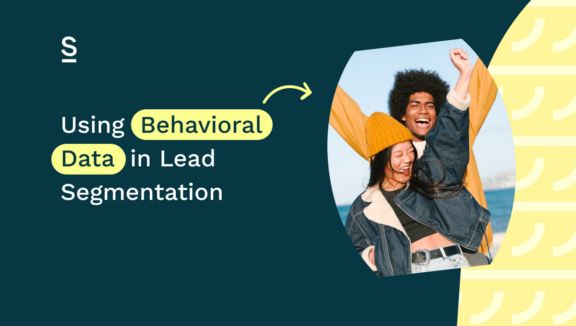Using Behavioral Data in Lead Segmentation

Behavioral data and lead segmentation: one of the sweetest combinations known to sales reps the world over.
Wondering what we’re talking about? Let us explain. Combining behavioral data and lead segmentation is like baking a really, really delicious cake. Step into the Surfe kitchen for a moment, and we’ll take you through the recipe:
- Take behavioral data (interactions from your prospects and customers like website views, newsletter signups, and social media engagements)
- Mix it with lead segmentation principles
- Dine out on the results – like improved personalization, enhanced targeting and conversion rates, and improved customer retention
Sounds nice, right? Now it’s time for a full demonstration. By the end of this article, you’ll understand exactly how behavioral data can be used to create more effective lead segmentation strategies:
- Understanding behavioral segmentation
- Types of behavioral segmentation
- Tools and technologies for behavioral segmentation
- How to implement behavioral segmentation in your own strategy
Pull your aprons on (and don’t you dare laugh at us in our chef’s hat):
Understanding behavioral segmentation
First things first, a quick definition. Behavioral segmentation is grouping your leads and customers according to their behavior. Simple!
It’s not the only way you can segment your customers. Others include:
- Demographic segmentation: grouping your leads and customers by variables like gender, age and role.
- Firmographic segmentation: the B2B process of grouping your leads and customers by the type of company they work at and its attributes.
Companies use behavioral segmentation to inform decisions about what to do next. Ultimately, it’s a way to understand your customers more deeply – and then show them just how well you understand them. Benefits include:
- Enhanced targeting and conversion rates: you’ll be able to customize your outreach like never before – and enjoy the conversion rates to prove it.
- Improved retention: showing you care goes beyond the sale. Make sure you show your customers too, and they’ll come back for more year-on-year.
Types of behavioral segmentation
There are several types of lead segmentation:
Purchasing behavior
Looking at your contacts’ purchasing histories should give you a clue as to what they’re going to do next, and how you can tailor marketing messages to support their future activities.
There are four patterns of buying behavior, two of which are most relevant to B2B purchases:
-
- Complex: these purchases are higher ticket and made less often. As a result, buyers will tend to do their due diligence; research, price comparisons, speaking to different providers, and so on.
- Dissonance reducing: these are similar to complex purchases in that they require a lot of research and consideration – but the prospect will struggle to see a difference between their options.
Let’s take an example. If your behavioral data shows you that your purchase process is a complex one, you’ll want to provide plenty of content to support your prospects’ research – at the appropriate time.
Usage
Usage-based behavior data is gathered from your customers’ product usage. For example, do they use your product every day, or sporadically? Do they stay on it for hours, or log on and off?
The type of content you send to those who use your product a lot should differ from those who don’t use it a lot. For example, if you want to nudge a customer into using your product more, you could highlight a certain feature to try in your messaging.
This type of behavior can also be extremely useful pre-purchase if your product offers a free trial – it gives you an idea of what your prospects care about, what they don’t and what they may or may not understand.
Occasion-based
Occasion-based data is used by companies that have products purchased for personal or universal occasions. For B2C products, this might be a birthday or a holiday like Valentine’s Day. A B2B example could be a software product used at the chance of the financial year.
Keeping track of when your prospects and customers purchase and why gives you an idea of when your product is most useful, and what it’s most used for. Once you’ve got an idea of common trends, you can use your insights to tailor messaging and outreach – offering a discount at the right time of the year, for example.
Loyalty status
This one does what it says on the tin: how loyal is your customer base? They could be new, returning or perhaps VIP customers that really advocate for your brand.
Driving customer loyalty is crucial for brands today (acquiring a new customer costs a lot more than retaining an current one). With that in mind, you’ll want to look at your advocates and returning customers and assess what they like about your product, why they prefer your company to a competitor and what customer experiences you can use to keep them loyal.
Benefits of behavioral segmentation
If you need a quick recap: we’ve covered what behavioral segmentation is and how you might use it for your business. Next up: why you should do it.
The benefits: personalization
Segment your leads and customers by their behavior, and you can take personalization to a new level. The more you personalize, the more your prospects will feel like you know them – and the more likely they’ll be to buy into your product.
It’s worth noting that in 2024, customers expect personalization. We’re all familiar with brands calling us by our first name in emails (and having an uncanny knowledge about the last time we visited their website). Don’t do this, and you’ll stick out in a bad way.
Do do this, however, and you’ll see increased open rates and click-through rates for your email campaigns – plus a shortened sales cycle, as you’ll know exactly how to speak to your prospect’s pain points and needs.
The benefits: customer retention
Keeping your slices of the market share pie (yep, still got food on the brain) is an essential part of today’s B2B strategy. After all, adopting a new customer can cost a whopping five times as much as keeping a current one. No thanks.
Behavioral segmentation allows you to keep an eye on your most valuable customers, and send out personalized content and interactions to keep them obsessed with your product.
The benefits: churn prevention
Just as it helps you identify your most valuable customers, behavioral data also lets you identify who’s at risk of leaving. If someone hasn’t touched your product or opened your emails in months, alarm bells should be ringing.
You can use these insights to alert your CS team and create marketing campaigns to try and prevent churn – this could be anything from a refresher webinar to help them get the best out of the product to a discount around the time of contract renewal.
Even if you don’t manage to save the relationship, it will help with your profit and revenue predictions – say goodbye to the nasty surprise of a customer churning out of the blue.
Increased sales and conversion rates
Behavioral data is your secret weapon when it comes to driving your sales metrics up. Your hyper-personalized messages should move leads to prospect status. You’ll also be able to take control of the sales process by providing a more personalized consultation throughout the funnel.
You can also use historic data to figure out points of friction. Is there a part of the sales process where buyers tend to drop off – perhaps after the demo, or after the contract’s sent? If so, you can then test and iterate methods of improvement.
Tools and technologies for behavioral segmentation
The great thing about behavioral segmentation is that you don’t even need to do it yourself.
Ok, we’re exaggerating a little – but there are plenty of wonderful tools that can help you automate the process.
Unless you’re a data scientist and a salesperson (more power to you if that’s the case) AI can probably do a better job than you can at analyzing large datasets and identifying patterns. Use it to predict what’s going to happen, pick up on subtle trends you might have missed, identify customer sentiment and generate content off the back of these learnings.
You can also use AI to help with your lead-scoring efforts. By analyzing multiple data sources, at scale, you’ll have advanced lead profiles ready for you at no extra effort from you. And we all know that better lead scoring shows your sales and marketing teams where to direct their efforts and how to personalize their approach.
So we mentioned analyzing multiple data sources at scale – but how does that look like for the sale person on the ground? Of course, the sales person doesn’t have the time to be going through multiple data sets. That’s where Surfe comes in. You might have used our email finder that combines the power of the top email databases globally. Well we’re doing a similar thing with behavioral data as part of an intelligent enrichment engine.
Surfe sources and analyzes behavioral data and uses it to help you identify new target accounts, enrich their contact data, and sync it all into your CRM.
How to implement behavioral segmentation in your strategy
Sold? We thought so. Here’s how to implement behavioral segmentation in your strategy:
Collect and analyze behavioral data: go manual, or (much easier) use a tool like Surfe to do the hard work for you and provide deeper insights than you could manage yourself.
Creating segments based on identified behaviors: identified a segment of customers who don’t use your product as much? Create an action plan with personalized messaging, better targeted touch-points, and more to get your sales on track on track.
Build personalized marketing efforts and sales efforts for each segment: as well as sending out personalized email communications, you can use segment data to inform your LinkedIn outreach, campaigns across marketing channels and more. For example, your marketing team might create an exclusive event for your product advocates using customer data – or you might use historic behavioral data to identify new target leads to reach out to.
Measuring success: the mindset you want to adopt here is continuous learning. There’s no point in diving deep into your behavioral data, using what you find to identify meticulously personalized customer interactions, and then…doing nothing. Keep track of what’s working and what’s not, and use these valuable insights to tweak your future activities as needed.
Tip: make sure your data is clean and accurate. Keep it regularly updated to avoid interactions that miss the mark – there’s nothing more cringe than a brand trying to get down with the kids (in this case, your customers are the kids) and getting a really basic point wrong.
Let’s wrap it up!
Behavioral segmentation is your secret weapon when it comes to understanding and communicating with your customers. Get it right, and you’re looking at a faster sales cycle, more customer advocates and fewer churned clients. We believe that’s what they call a triple win. The cherry on top of the cake, if you will.
If you want to learn more about behavioral data, have read through some of these free resources:

Need the contact details for your future customers?
We’ve got you. Surfe* uses waterfall enrichment to find the best contact data for your LinkedIn contacts, and migrates it all over to your CRM at the touch of a button. Why not try it?
*which, by the way, is free to try
FAQs about using behavioral data in lead segmentation
What is behavioral segmentation with an example?
In a nutshell, behavioral segmentation is the action of grouping your prospects or customers together based on their behavior. For example, you might segment your customers based on how much they use your product, or your prospects based on their actions on your website.
What are the benefits of behavioral segmentation?
Effectively segment your prospect and clients by behavior, and you’ll enjoy:
- Increased personalization: understand your contacts on a deeper level by gathering data on their day-to-day activities related to your product
- Retained customers: find out who your most valuable customers are, and use messaging and customer marketing to delight them even more
- Fewer churned customers: find out if a customer’s going to churn before they know it themselves, and take the necessary actions to turn things around
What are the four types of behavioral segmentation?
The four types of behavioral segmentation are:
- Purchasing behavior: do they approach your product as a complex or simple thing to buy?
- Usage: how often do your customers use your product? What do they use it for, and how long does each session last?
- Occasion-based: do your customers make a purchase at a certain time of the year, or for a personal event like a birthday?
- Loyalty status: does your customer return to your brand time and time again, or is there evidence they’ve been tempted by a competitor?
What is a lead segment?
A lead segment is a proportion of your overall lead or customer list, grouped together on a unifying feature. Common ways to segment your leads or customers include:
- Demographic segmentation: grouping your prospects or customers together based on demographics like age, location, gender and role
- Firmographic segmentation: grouping your prospects or customers together based on the type of business they work at and common company attributes
- Behavioral segmentation: grouping your prospects or customers together based on their behavior


